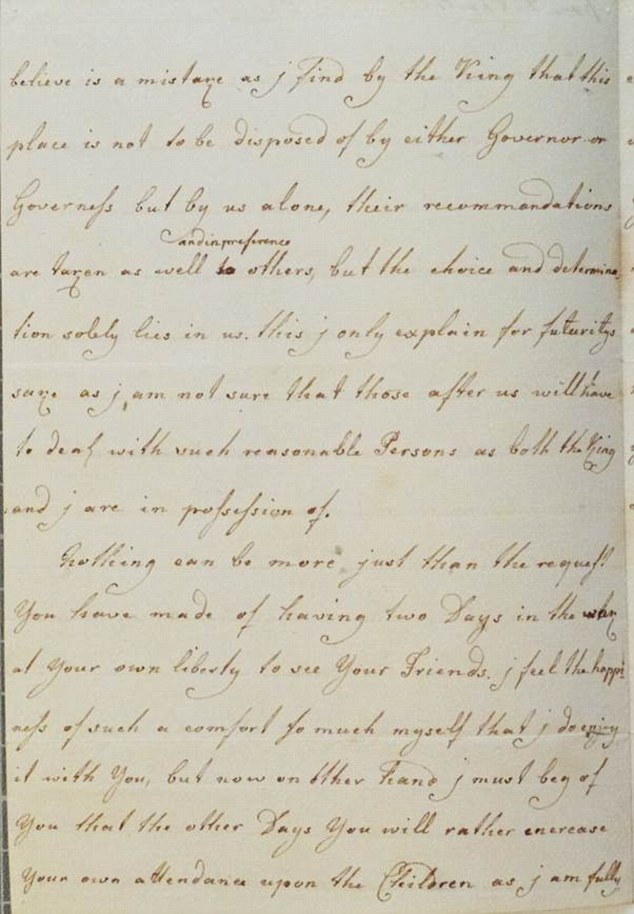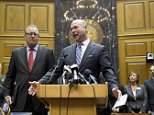Letters about the American War of Independence and 200-year-old poetry written by the Shah of Persia: The Queen left 'stunned' by previously unseen epistles from George III's archive
- An archive of royal letters and books unseen for 200 years is to be digitised
- The Queen launched project at Windsor Castle's Royal Library
- Included are letters shedding light on the American War of Independence
- Also a 200-year-old poetry book written by the Shah of Persia in 1812
- Queen joked that, 'You don't get gifts like that any more!'
- Also includes an essay by George III and letters from Queen Charlotte
A 200-year-old book of poetry gifted to George III and letters from Rear Admiral Sir Samuel Hood written during the American War of Independence are among a treasure trove of documents released by royal archive yesterday.
The collection, which was amassed by George III and has been under lock and key for 200 years, has been digitised and the Queen was at Windsor Castle for the launch.
Declaring herself 'stunned' by the collection, none of which she had seen before, Her Majesty admired the poems, which were written by the Shah of Persia himself, and quipped: 'You don't get gifts like that any more!'
Scroll down for video

Treasure trove: The Queen inspects a 200-year-old book of poetry presented to George III

Incredible: The book (back, beside the Queen), was presented by the Shah of Persia in 1825
Along with the poems, which were given to the Hanoverian monarch in 1812, was a collection of scientific instruments, many of which were considered advanced in their day.
Other documents shown to the Queen touch on some of the most important events in history, among them the American War of Independence.
One particularly significant document was written by Rear-Admira Hood and details naval failings during the battle of Chesapeake Bay.
The battle, between British and French fleets, resulted in the last significant British army in the Thirteen Colonies being cut off - and led directly to US independence.
Other papers include an essay written by George III on the relationship between the monarch and parliament and notes from Queen Charlotte to her children's governess.

Significant: This letter was written by Rear-Admiral Sir Samuel Hood following the Battle of Chesapeake Bay

Royal handiwork: This essay on the relationship between monarch and Parliament was written by George III
The viewing took place in the Royal Library at Windsor Castle and include papers owned and written by George I, II, III and George IV, who ruled as Prince Regent during his father's famous madness.
George III was believed to have suffered from porphyria, a hereditary disease that affects the blood and can cause mania.
The digitisation of the 350,000 documents, a task that will be undertaken by academics from King's College London, will begin in the next few weeks.
While the vast majority of the collection are papers from George III, other documents from reigns of George I, George II, George IV and William IV will also be made available.
It is hoped the work will transform the understanding of Georgian Britain and its monarchy, at a time of profound cultural, political, economic and social change.

Stunning: The Queen was also shown the 1765 Eardley Norton clock (right) by Oliver Urquhart Irvine (left)

Project: The Queen greets Lynn Forney Young from the Daughters of the American Revolution organisation

Stunned: The Queen declared herself 'stunned' by the contents of the archive, all previously unseen

Big job: The digitisation of the 350,000 papers will be overseen by academics from King's College London
'The Queen said she was stunned by the beauty of the gifts and letters, especially the Persian book of poetry that she was looking at earlier,' said Dr Joanna Newman, vice principal of the university, afterwards.
'She talked a great deal about the letters, she said she was extremely interested in them, that they were very impressive and that she is very happy for the collaboration to be with King’s College.'
Other letters seen by the Queen include one from John Jay, a merchant who went on to become one of the Founding Fathers of the US, to future president George Washington in 1781.
Another, dating from the same period, was sent to George III by a spy named Aristarchus.
The project is part of a wider programme of work by the Royal Archives to open up access to its primary source material, following the success of the digitisation of Queen Victoria’s journals in 2012.
Professor Edward Byrne, president and principal of King’s College London, said: 'King’s was founded by King George IV - George III’s eldest son and successor - and with Her Majesty the Queen as our present day patron, we are delighted and honoured to have been approached by the Royal Household to work on this prestigious project and to continue our long history of association with the Crown.
'This joint project, to open up over a century of Royal Archives, provides an unprecedented scale of opportunity to discover more about the Georgians.'

Royal childhood: This letter is from Queen Charlotte to her children's governess, Lady Charlotte Finch

Involvement: The British Library, which is also involved, was represented by Baroness Blackstone (centre)
-
 Is this the most extreme prank in the world?
Is this the most extreme prank in the world?
-
 NYPD Cop unleashes abusive tirade on Uber driver
NYPD Cop unleashes abusive tirade on Uber driver
-
 It's a hoot! Mesmerised owl turns up on door stop
It's a hoot! Mesmerised owl turns up on door stop
-
 Shocking footage shows car exploding after police use taser
Shocking footage shows car exploding after police use taser
-
 Identical triplets marry on the same day at the same time
Identical triplets marry on the same day at the same time
-
 Mime through time! Female sketch trio mime the ages of music
Mime through time! Female sketch trio mime the ages of music
-
 Car escapes tow truck by driving off the back of it
Car escapes tow truck by driving off the back of it
-
 17-year-old dies after crashing stolen car into a pole
17-year-old dies after crashing stolen car into a pole
-
 EXCLUSIVE: Joe Giudice on family life at home without Teresa
EXCLUSIVE: Joe Giudice on family life at home without Teresa
-
 Paws for playtime! Boy plays with bear at the zoo
Paws for playtime! Boy plays with bear at the zoo
-
 11 former Atlanta educators found guilty in cheating scandal
11 former Atlanta educators found guilty in cheating scandal
-
 Physics experiment goes wrong as teacher hits co-worker with...
Physics experiment goes wrong as teacher hits co-worker with...
-
 EXCLUSIVE: Who needs Rosie O'Donnell? Monica Lewinsky tapped...
EXCLUSIVE: Who needs Rosie O'Donnell? Monica Lewinsky tapped...
-
 The world’s oldest person dies aged 117 weeks after saying...
The world’s oldest person dies aged 117 weeks after saying...
-
 Dead oil heir Andrew Getty had serious medical condition...
Dead oil heir Andrew Getty had serious medical condition...
-
 Heart recipient, 17, dies in high-speed police chase crash...
Heart recipient, 17, dies in high-speed police chase crash...
-
 Atlanta cheating scandal teachers go to cells in hand-cuffs:...
Atlanta cheating scandal teachers go to cells in hand-cuffs:...
-
 Yoko pays tribute to Cynthia, the secret wife John Lennon...
Yoko pays tribute to Cynthia, the secret wife John Lennon...
-
 EXCLUSIVE - Teresa Giudice behind bars: Housewives star...
EXCLUSIVE - Teresa Giudice behind bars: Housewives star...
-
 'I regret to inform you that I am unable to accept your...
'I regret to inform you that I am unable to accept your...
-
 Facebook unveils its new Silicon Valley office with...
Facebook unveils its new Silicon Valley office with...
-
 'I do, I do, I do': The moment identical triplets married on...
'I do, I do, I do': The moment identical triplets married on...
-
 'We two women stood firm in the Beatles family': Yoko Ono...
'We two women stood firm in the Beatles family': Yoko Ono...
-
 Frank Sinatra 'had a vasectomy and Ronan Farrow is NOT his...
Frank Sinatra 'had a vasectomy and Ronan Farrow is NOT his...























































































































































































































































